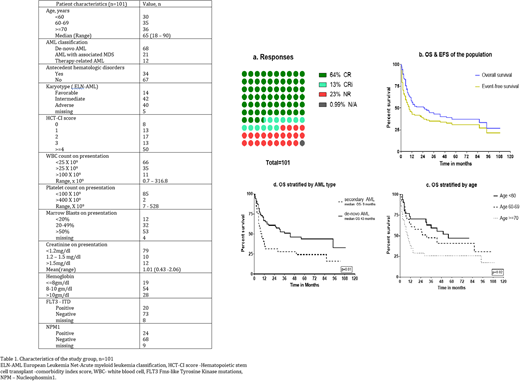Abstract
Introduction
In acute myeloid leukemia (AML), dose intensification of "7+3" has not produced improved outcomes. At our center, we evaluated an intensive "5+1" regimen of high dose mitoxantrone (HDM) with high dose cytarabine (HiDAC) in all newly diagnosed AML patients. We present here our experience of this regimen at our institution.
Patients and Methods
The treatment regimen included bolus HiDAC at 3000 mg/m2 over three hours on days 1 to 5 and HDM 80 mg/m2 once on the second day immediately after the completion of cytarabine infusion. A total of 101 consecutive patients were treated from January 2009 to March 2013 with this regimen. There were twelve exceptions to the regimen dosages, where patients received a lower dose of 60 mg/m2 of mitoxantrone due to their significant comorbidities. The mean doses of mitoxantrone and Cytarabine administered for the whole cohort was 76 mg/m2 and 2844 mg/m2/day respectively. Patients who achieved CR were further consolidated by HiDAC chemotherapy cycles (1-4) and/or hypomethylating agent q28 day cycles. Patients with intermediate/adverse risk group were evaluated and considered for allogeneic transplant. Survival rates were calculated by the Kaplan-Meier method.
Results
The median age was 65 years (range 18-90). The total number of patients in the age group <60, 60-69 and ≥70 were 30(29.7%), 35(34.6%) and 36(35.6%) respectively. Patients in favorable, intermediate and adverse cytogenetics group as per European Leukemia Net(ELN)-AML 2017 criteria were 16(15.8%), 40(39.6%) and 41(40.5%) respectively. 33 patients had secondary AML (therapy-related AML, AML with antecedent MDS or CMML, or de novo AML with MDS related cytogenetics abnormalities). The overall complete response (CR) was 76.2% (77/101). 22% (23/101) were either primary refractory or had partial responses. The CR rates in patients <60, 60-69 and ≥70 age groups were similar at 80% (24/30), 74.2% (26/35) and 77.1% (27/35) respectively. The de-novo AML patients had higher CR 83.5%(56/67) compared to secondary AML 63.6%(21/33), p=0.04. The 4 and 8-week mortality in our cohort was 3/101 (2.9%) and 7/99 (7%) respectively. Median follow-up among survivors was 62 months (range 1-109 months). The median overall survival (OS) stratified by age group < 60, 60-69 and >=70 years were 56, 31 and 9 months respectively (log-rank, p=0.02). The median overall survival in patients with secondary AML was 9 months versus 43 months in de-novo AML patients. Sixty patients underwent transplant during consolidation, 47 (46.5%) were allogeneic and 13 (12.8%) autologous. 51.7% (45/84) of patients with intermediate/adverse cytogenetic risk groups as per ENL/AML criteria proceeded to allogeneic transplants. Among these 84 patients, the percentage of patients able to proceed to transplant in age groups <60, 60-69 and ≥70 years were 75% (18/24), 60.7 % (17/28) and 31.2% (10/32) respectively.
Conclusion
In conclusion, HDM based chemotherapy regimen produces high CR rates, is well tolerated and more patients can undergo curative post-remission therapy including stem cell transplant. Together with the low number of toxic deaths this induction regimen warrants further investigation.
Raffel:Magenta Therapeutics: Employment, Equity Ownership.
Author notes
Asterisk with author names denotes non-ASH members.


This feature is available to Subscribers Only
Sign In or Create an Account Close Modal